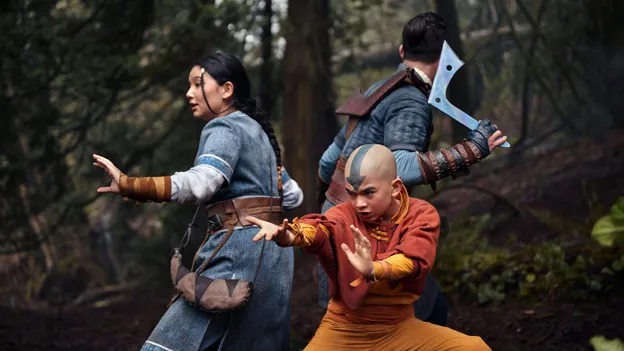Rather than pursuing its own goals, the recently released live-action version of the hugely successful animated fantasy exists only to take advantage of people’s nostalgia.
observing the live-action Netflix production of the wildly successful noughties animation Avatar: The Last Airbender makes me think of a clever article I saw recently in Dazed that said pop culture is feeding people’s need to live in a state of permanent adolescence. In their worst cases, beloved work remakes feed into this infantilizing drive, giving in to the need to make everything old—that viewers once loved—new again. Based on the Nickelodeon television program produced by Michael Dante DiMartino and Bryan Konietzko, who envisioned a complex fantasy world with many nations called after the elements fire, earth, water, and air, as well as a few chosen individuals
Live-action remakes of animations frequently feel doomed from the start, while remakes in general are not always a terrible or ignoble idea. The tension that arises from reproducing drawings in real time is immediately apparent. Characters in animation can change visually in a variety of ways depending on what the scene calls for. Since there are two different sorts of expression at play, the same situations or character design decisions won’t always work in the same manner; the animation must be modified rather than simply lifted
The fact that this Airbender seems to be merely meant to be “that show you remember, but what if it was real” is regrettable because it substitutes more somber scenery for the original’s visually expressiveness in order to emphasize the brutality of its war plot.
The popular animation licenses that the streamer has acquired and turned into live-action series have become something of a business strategy; a Mobile Suit Gundam adaptation is currently in the works. For instance, Netflix’s 2021 adaptation of the anime Cowboy Bebop felt more like it copied the original work than it did acknowledging its influences (such as westerns, yakuza films, and film noir) and adding new ones. Similar to Airbender, it would aggressively and continuously reference its animated predecessor without actually connecting with it, failing in its attempt to reduce the animated original’s larger-than-life characters to what has become the standard operating procedure for streamers: a combination of subdued color palettes with flat lighting and composition, as well as the belief that recognizable imagery would be relatable.
In certain ways, Airbender deviates from the source material, hardly making an effort to reconsider it. The most heinous instance is in the second episode, Warrior, which mimics an animation story without portraying Sokka, the warrior of the Water tribe, in a misogynistic manner. It eliminates the challenge to his worldview and conveys the idea that the authors don’t think the older audience, who it appears to be aimed at with its harsher tone, can comprehend the subtleties of the tale.
It’s indicative of the show’s approach in that it rejects any hint of moral ambiguity while presenting itself as a more sophisticated take on the same topic both visually and sonically. This version therefore doesn’t really justify itself. Is it
A few people have done excellent live-action remakes of well-known animated films. Despite being a box office failure, the 2008 movie adaptation of the manga series Speed Racer has a strong artistic quality. According to interviews, Lana and Lily Wachowski adapted cubist art ideas to their approach, carrying over the anime’s stylings into their own visual language.It understood the concept of Speed Racer and employed powerful stylization to bridge the gap between the realistic and the comical, which is fatal for many animation to live-action remakes.
Sometimes, Netflix has even gotten things right. Based on the manga series with a pirate theme, One Piece from last year enabled itself to embrace the sincerity of the original.
Remakes don’t always have to be the result of fading nostalgia, despite the fact that they are frequently mocked by both reviewers and the general public. That much is true for all platforms: only this coming week will Final Fantasy VII Rebirth, the second installment of the Final Fantasy VII Remake trilogy, be available on the PlayStation 5. Remakes of video games are driven by a variety of factors, including the desire to improve gameplay and graphics as well as the rarity of the original releases. However, compared to the lifeless copy of Airbender in the live-action film, the Final Fantasy VII Remake games’ inventive storytelling and wonderfully bizarre turns really shine through. The games address the notion that a character’s fate is predestined because the characters in the FFVII Remake installments struggle against it.
Both live-action adaptations of animation and remakes have their place, but only if they have a clear purpose in mind for the work, rather than just reproducing fan favorites. Not only does the current adaptation of Avatar: The Last Airbender visually appropriate cartoon material in an odd and awkward way, but it also remains stuck in the past, a show that has steadfastly refused to evolve into something more than a parody.





